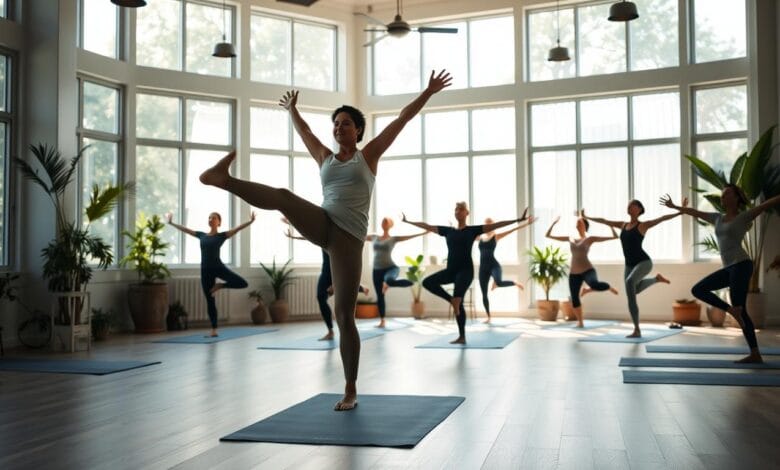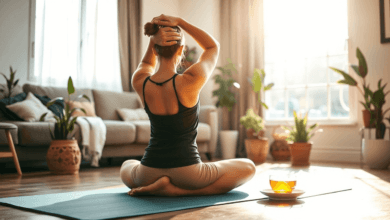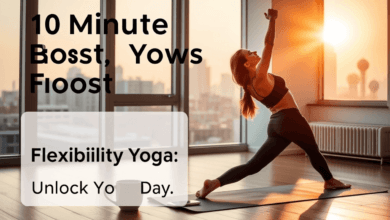Discover the Best Yoga Balance Exercises for a Centered Practice

Yoga balance exercises are crucial for building strength and focus. They combine physical stability with mental clarity. This makes them vital for all yoga practitioners.
Whether you’re new or experienced, yoga improves your posture, coordination, and mind-body connection. Poses like Tree and Warrior III help steady your body and mind. This guide covers simple techniques to advanced postures, showing how balance exercises boost wellness.
Each section explains how yoga balance exercises link breath, alignment, and intention. This creates a more mindful routine.
boosting your health, energy and well-being at the same time
Key Takeaways
- Balance exercises boost physical stability and mental focus.
- Yoga for better balance adapts to all skill levels, from beginners to experts.
- Core poses like Tree and Warrior III form the foundation of balance training.
- Improved alignment and breath control come from consistent practice.
- These techniques apply to daily life, supporting health and mindfulness.
Understanding the Importance of Balance in Yoga
Balance is key in yoga, affecting both physical health and mental clarity. Poses like Tree Pose or Warrior III boost strength and awareness. These exercises are more than physical challenges; they’re for overall well-being.
The Physical Benefits of Balance Work
Yoga balance exercises strengthen small muscles often missed in regular workouts. They improve posture and joint stability by engaging core muscles. For instance, balancing on one leg makes ankles and knees stronger, lowering injury risks.
- Builds core and lower-body strength
- Sharpens spatial awareness and coordination
- Prevents falls and improves mobility
boosting your health, energy and well-being at the same time
Mental Focus and Balance Connection
Maintaining balance requires mental focus. Holding Half Moon Pose, for example, helps you stay present. This reduces stress and sharpens your mind.
“Balance is the foundation of all movement and mindfulness.”
Practitioners learn to control their thoughts, a skill useful in managing daily stress. Yoga also builds emotional resilience by teaching us to learn from mistakes.
boosting your health, energy and well-being at the same time
Balance as a Metaphor for Life
Yoga’s balance principles reflect life’s challenges. Think about this comparison:
| Yoga Balance | Life Balance |
|---|---|
| Adjusting stance mid-pose | Adapting to change |
| Recentering after wobbling | Recovering from setbacks |
| Breathing through instability | Maintaining calm under pressure |
Every wobble on the mat teaches patience. This patience is valuable when facing life’s unpredictability.
boosting your health, energy and well-being at the same time
The Science Behind Yoga Balance Exercises
Balance in yoga depends on three main systems: the vestibular system, proprioception, and neuromuscular coordination. Yoga for stability strengthens these systems. It trains the body to adjust to changes in weight and posture.
Each pose makes muscles talk to the brain. This improves spatial awareness and control.
- Vestibular system: Inner-ear sensors detect head position, sending signals to maintain upright posture.
- Proprioception: Nerve receptors in joints and muscles track body position without visual cues.
- Neuromuscular coordination: Brain and muscles work together to adjust movements instantly.
“Eight weeks of improve balance through yoga practice increased proprioceptive sensitivity by 23% in participants aged 50+.”
Knowing your body’s center of gravity is key. In Tree Pose, standing on one foot makes muscles work hard. A study in the Journal of Bodywork and Movement Therapies showed a 18% reduction in sway after regular practice.
Yoga also boosts brain areas like the cerebellum. This area helps with motor control.
Repeating poses builds neural connections. This improves reaction time. So, poses like Warrior III become steadier over time. This science backs up why regular practice boosts both physical and mental balance.
boosting your health, energy and well-being at the same time
Essential Foundations for Successful Balancing Poses
Learning balancing poses in yoga starts with key principles. These help build strength and confidence. They also improve alignment, focus, and stability, making yoga accessible to everyone. Start here to build a strong foundation for all poses.
Proper Alignment Principles
Alignment is crucial for safety and effectiveness. Stand with feet firmly planted, hips even, and spine straight. Make sure ankles and knees are strong.
Avoid tilting your pelvis. Imagine a line from your head to your tailbone. Adjust your stance width based on the pose.
Core Engagement Techniques
Engage your abdominal muscles like a corset. Pull your navel inward while expanding your ribs. This helps stabilize your torso in poses like Warrior III.
Gaze Points (Drishti) for Stability
A steady gaze quiets the mind and anchors the body. Choose a fixed point ahead, keeping eyes still even when shifting weight. Tradtional drishti like “nasagrai” (tip of the nose) or “bindi drishti” (third eye) reduce wobbling by focusing attention.
Breath Control During Balance Poses
Sync your breath with your movements. Inhale to rise, exhale to stabilize. Use 4-4 breathing: 4-second inhale, 4-second exhale.
For tough poses, take longer exhalations to calm your nerves. Shallow breathing can upset your balance—steady breathing keeps you steady.
Beginner-Friendly Yoga Balance Poses
Learning balance starts with simple poses that focus on grounding and being present. These yoga balance poses for beginners help improve stability and clear your mind. Start each pose near a wall for support and focus on steady breathing to stay calm.
Tree Pose (Vrksasana)
Stand with feet hip-width apart. Lift one foot to rest on the inner thigh or calf. Press palms together at the heart, gazing forward. Keep the standing knee slightly bent. For extra stability, lower the raised foot to a block.
- Breathe deeply to stay centered
- Avoid tensing shoulders; keep them relaxed
boosting your health, energy and well-being at the same time
Mountain Pose (Tadasana)
This basic stance is key for building balance. Stand with weight evenly on both feet. Roll your shoulders down and gently engage your core. This pose improves posture and body awareness, which are crucial for more advanced yoga poses for balance.
Eagle Pose (Garudasana)
Wrap one leg around the other while folding forward slightly. Balance on the grounded foot while keeping hips level. Use a chair for support if needed. This pose sharpens focus and limb coordination.
Warrior III (Virabhadrasana III)
Shift weight onto one leg while extending the other parallel to the floor. Lean forward slightly, arms reaching ahead. Engage glutes to prevent leaning too far back. Practice near a wall for initial attempts.
Practice each pose 3-5 times daily, holding for 5-10 breaths. Celebrate small progress—every session strengthens neuromuscular connections critical for balance. Prioritize form over duration to avoid strain.
boosting your health, energy and well-being at the same time
Intermediate Yoga Balance Exercises to Elevate Your Practice
Intermediate yoga balance exercises build on basic poses. They focus on stability and coordination. Half Moon and Dancer’s Pose require strong core muscles and precise alignment.
These poses challenge you to breathe deeply while moving. They help you stay calm and focused.
“Balance is the bridge between intention and action.”
| Pose | Key Focus | Alignment Cues |
|---|---|---|
| Half Moon (Ardha Chandrasana) | Single-leg strength, lateral spinal extension | Stack hips; engage outer standing leg |
| Dancer’s Pose (Natarajasana) | Posterior chain activation, spinal rotation | Press back foot into hand; keep knees aligned |
| Standing Split (Urdhva Prasarita Eka Padasana) | Hamstring flexibility, hip mobility | Square hips forward; engage quads of lifted leg |
| Revolved Half Moon (Parivrtta Ardha Chandrasana) | Twist integration, rotational stability | Rotate chest toward the sky; anchor standing foot |
Learning these poses takes time. Start with support from a wall and gradually use less. Focus on small adjustments, like feeling the base of your big toe.
Practice 2-3 times a week. You’ll see better balance and control over your muscles.
- Maintain drishti (gaze point) to enhance focus
- Hold each pose for 5-8 steady breaths
- Engage the bandhas (energy locks) for core stability
Getting better at yoga balance takes regular practice. Focus on doing poses right, not for how long. This helps avoid injuries and builds real strength.
boosting your health, energy and well-being at the same time
Advanced Balancing Poses for Experienced Practitioners
For yogis ready to challenge their limits, advanced yoga balance poses offer a gateway to mastery. These postures demand precision, strength, and mental resilience, building on foundational skills. Safety remains key—always practice with awareness of your limits.
Handstand (Adho Mukha Vrksasana)
Start near a wall for support. Press hands firmly, engage core, and kick up with one leg. Focus gaze between hands to stabilize. Progress to freestanding balances once confident. Tip: Use a spotter for extra safety.
Crow Pose Variations (Bakasana)
- Master arm balances by lifting knees to elbows and gripping ankles.
- Transition smoothly between crow and side crow to enhance coordination.
- Maintain drishti to avoid wobbling.
Side Plank Variations (Vasisthasana)
Balance on one arm and leg, then add binds by clasping hands behind the back. Lift the lower leg higher to deepen engagement. Focus on breathing steadily throughout.
Flying Pigeon (Eka Pada Galavasana)
- From crow pose, extend one leg forward.
- Shift weight to maintain balance on the other leg.
- Hold briefly, then return to starting position.
“Balance isn’t just about legs and core—it’s trusting your breath to guide you.”
These yoga poses for balance require patience. If unsure, modify with blocks or a wall. Prioritize form over height. Celebrate progress, not perfection.
Creating an Effective Yoga Balance Routine
A consistent balance yoga routine helps you see real progress. Start with simple poses and gradually add more. Watch how your balance improves your practice.
10-Minute Daily Balance Practice
- Warm-up: 3 minutes of Mountain Pose (Tadasana) with eyes closed
- Core sequence: 3 poses (e.g., Tree, Warrior III, Eagle) held 15-30 seconds per side
- Cool-down: Child’s Pose with deep breathing for 2 minutes
30-Minute Complete Balance Sequence
- 5-minute warm-up: Cat-Cow flow followed by standing warm-ups
- 15-minute yoga balance exercises: Rotate poses weekly (e.g., Half Moon, Crow, Dancer’s Pose)
- 10-minute cool-down: Legs-Up-The-Wall Pose with meditation
Incorporate Balance into Existing Routines
Make your usual flows better by adding balance:
- Insert Tree Pose between Sun Salutation A and B
- Hold Warrior III during Hatha transitions
- End restorative sessions with Half Lord of Fishes Pose
| Week | Focus Areas | Key Poses |
|---|---|---|
| 1-3 | Basic stability | Tree, Mountain, Eagle |
| 4-6 | Core integration | Warrior III, Crow |
| 7-9 | Dynamic control | Flying Pigeon, Handstand variations |
Follow this 9-week plan to move from basic to advanced poses safely.
boosting your health, energy and well-being at the same time
Props and Modifications to Improve Balance Through Yoga
Yoga makes it easier to balance with the right tools and adjustments. Blocks, straps, and walls help turn tough poses into chances to grow. This is true for everyone, no matter their skill level.
Using Blocks, Straps, and Walls
- Blocks help keep Tree Pose steady for beginners who wobble.
- Straps support arm balances for those with stiff arms.
- Walls guide Half Moon Pose, helping with alignment.
Modifications for Common Challenges
Use a chair in Warrior III to strengthen weak ankles. For tight hips, try Pigeon Pose with a bolster under your pelvis. If your wrists hurt, try modified Crow to keep your core strong.
Adaptive Approaches for Different Body Types
Got shorter legs? Use a folded blanket under your heels in Mountain Pose. Wide shoulders? Spread your legs wider in Eagle Pose. Yoga fits everyone when it matches their body.
These tools help you respect your body’s needs while still growing. Regular practice with careful adjustments boosts your confidence in yoga balance over time.
Troubleshooting Common Balance Difficulties
Mastering yoga for stability often requires navigating setbacks. Wobbly legs, dizziness, or scattered focus are normal hurdles. Let’s break down solutions for these roadblocks using proven techniques to improve balance through yoga.
- Uneven leg strength: Practice lunges and warrior poses on the weaker side first.
- Ankle instability: Strengthen with seated toe taps or use a strap around the foot.
- Inner ear imbalance: Start seated or against a wall until vertigo eases.
Mental blocks:
- Fear of falling? Anchor gaze on a fixed point (drishti) like a wall mark.
- Impatience? Track weekly progress with a journal—small gains add up.
“After three months of modified tree pose practice, I halved my wobble time,” says yoga therapist Linda Nguyen, citing her client’s progress. “Consistency matters more than perfection.”
For persistent issues, pair poses with breathwork. Slow exhalations calm nerves, while micro-adjustments in stance can reset alignment. Remember: even elite practitioners refine balance daily. Experiment with these strategies to build resilience and trust in your practice.
boosting your health, energy and well-being at the same time
Yoga for Balance and Stability in Specialized Populations
Yoga helps groups with special needs. Seniors, athletes, and those recovering from injuries can get better balance and strength. It’s a way to boost physical and mental health.
“Balance training reduces fall risk by 37% in older adults.” – National Institute on Aging
boosting your health, energy and well-being at the same time
Seniors and Fall Prevention
Yoga helps seniors by strengthening ankles, hips, and core. They do poses like seated tree pose (Vrksasana) to lower fall risks. These poses also build confidence.
Using walls or props makes standing poses safe. This way, seniors can practice without worry.
Athletes and Performance Enhancement
Athletes benefit from yoga’s ability to improve balance. Single-leg balances help runners stay agile. Inversions, like headstands, make rock climbers’ shoulders stronger.
Yoga routines are designed for specific sports. For example, runners do lunge poses to improve hip mobility. Sprinters practice Warrior III variations to enhance their speed.
boosting your health, energy and well-being at the same time
Post-Injury Balance Rehabilitation
Yoga is part of recovery plans for injuries. People with ankle sprains start with seated ankle circles. Then, they move to half-moon pose (Ardha Chandrasana) with support.
Those with ACL tears do modified lunges. This helps them build strength without putting too much strain on the knee.
| Population | Key Exercises | Benefits |
|---|---|---|
| Seniors | Chair tree pose | Improved mobility, reduced fall rates |
| Athletes | Warrior III variations | Enhanced sport-specific coordination |
| Post-injury | Supported half-moon | Gradual strength rebuilding |
Getting help from physical therapists or certified yoga therapists is key. They ensure you progress safely. Always talk to a specialist before starting a yoga program.
boosting your health, energy and well-being at the same time
Conclusion: Integrating Balance Exercises Into Your Yoga Journey
Mastering balance in yoga is a journey that combines physical strength with mental focus. This article has shown various poses, from Tree Pose to Handstands, that improve strength and concentration. A regular balance yoga routine also boosts stability, both on and off the mat.
Each pose, whether done alone or as part of a sequence, strengthens the connection between mind and body. This is key to yoga.
Remember, progress is not about being perfect. Every wobble is a step towards growth. Use props or modifications if needed. Balance in yoga is like life’s challenges; it’s about staying centered through change.
These exercises help prevent falls for seniors and improve athletic performance. Start small, set goals, and enjoy each session. It’s a path to mindful resilience.
Make balance exercises a part of your routine, even just 10 minutes a day. Join yoga communities or use guided resources to stay inspired. As you improve, you’ll not only become more physically steady but also more confident in facing life’s challenges.
Balance is a journey, not a destination. See it as a lifelong friend on your yoga path.
boosting your health, energy and well-being at the same time
FAQ
What are some effective yoga poses for balance?
Effective yoga poses for balance include Tree Pose (Vrksasana), Warrior III (Virabhadrasana III), and Eagle Pose (Garudasana). These poses help engage stabilizing muscles. They also improve body alignment, helping you balance better.
How can beginners start incorporating balance yoga routines?
Beginners can start with foundational poses like Mountain Pose (Tadasana) and Tree Pose (Vrksasana). Focus on proper alignment and core engagement. This creates a solid foundation for stability.
What is the significance of breath control during balance poses?
Breath control is key during balance poses. It helps maintain focus and reduces tension. By coordinating breath with movement, you can improve stability and performance in balancing poses.
Can yoga improve balance for seniors or those recovering from injuries?
Yes, yoga can improve balance for seniors and those recovering from injuries. Specific balance yoga exercises, tailored to their abilities, can enhance stability. They also prevent falls and promote strength and mobility.
What are some advanced yoga balance poses?
Advanced yoga balance poses include Handstand (Adho Mukha Vrksasana), Crow Pose Variations (Bakasana), and Flying Pigeon (Eka Pada Galavasana). These poses challenge stability and coordination. They require a strong foundation and focus.
How does yoga help enhance mental focus alongside physical balance?
Yoga enhances mental focus during balance poses by requiring concentration. This practice cultivates mindfulness. It connects your body and mind, reducing stress and promoting well-being.
What modifications can I use to improve balance through yoga?
Modifications like using props such as blocks and straps can improve balance. They provide support during poses. Practicing near a wall can also help build confidence and stability, especially for beginners.
How often should I practice yoga balance exercises to see improvements?
Practicing yoga balance exercises 2-3 times a week can lead to significant improvements. Consistency is key. Incorporating short balance routines into your regular practice can help reinforce skills.



